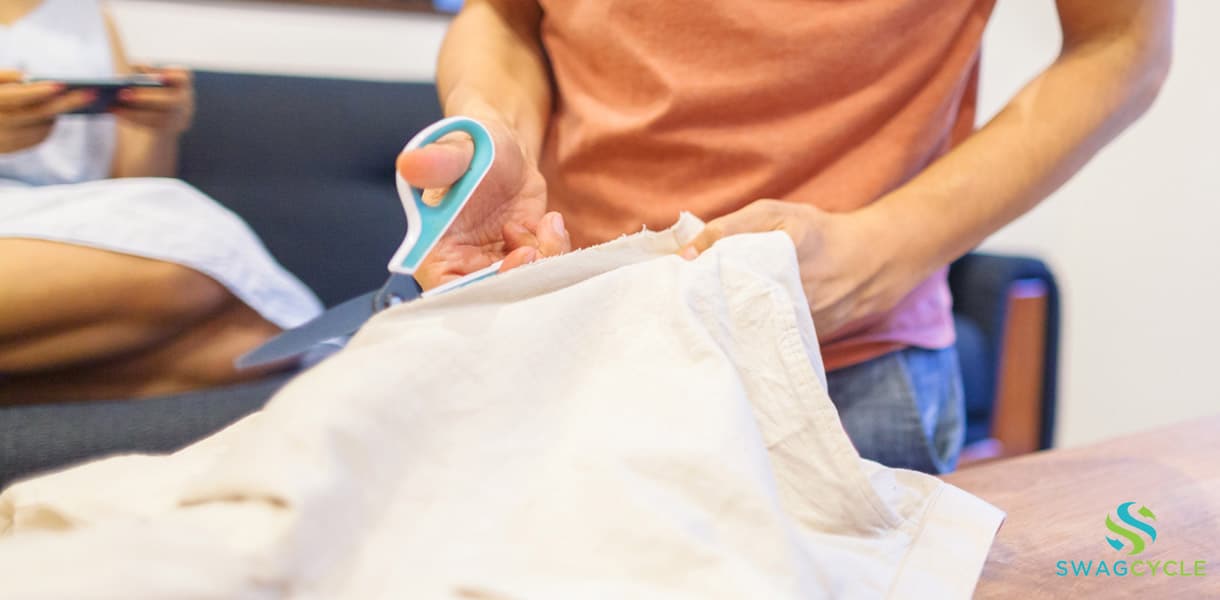Upcycling is a unique trend that is growing in popularity. Upcycling goes beyond recycling waste because the process doesn’t require degradation of the original material. Rather, upcycling transforms or repurposes old goods into newer items of higher perceived value. While there are several ways to upcycle your clothes and old items, we will focus on the top four we’ve found.
1. Brand New Fashion Apparel from Old Tee Shirts and Materials
It’s a fact that when we mention or discuss waste, we usually don’t think of our old clothing, be it worn out or ill-fitting denim, pilled sweaters, stained tee shirts, or even branded apparel from old marketing campaigns. Most of the unwearable items are simply thrown away in the trash without the owner realizing its impact on the environment or the other uses for the good. According to an estimate by the U.S. Environmental Protection Agency (EPA), textile waste comprises about 5% of total landfill use in the United States.
However, the issue of waste apparel is not just a household issue but a significant retail and wholesale industrial challenge as well. Retail brands create large amounts of inventory that never sells, creating “dead stock” inventory. In addition, for example, when a player is traded from a sports team, demand for their old jerseys generally disappears overnight. As a result, the concept of textile upcycling is being researched and explored continuously as a solution to reduce apparel waste.
A textile upcycling practice that is gaining traction is the creation of new fashionable apparel from dead-stock merchandise. Refried Apparel in Massachusetts is a great example of an organization that is upcycling and creating ingenious clothing items from “an endless supply of surplus material.” According to their website, “Refried transforms already printed/decorated apparel and soft goods of all types into stylish fashion garments and accessories with one-of-a-kind appeal.”
Graphics and other parts of the fabric from these garments are cut into pieces of various shapes and sizes, mixed selectively to create an attractive color palette, and stitched together to produce a unique garment keeping the latest fashion trends in mind. Each of these upcycled clothing items is no less than a piece of art from a designer’s point of view.
2. Bags and Accessories from Repurposed Billboard Vinyl
When a billboard reaches the end of its advertisement period, it has historically been thrown into landfills. A massive volume of vinyl waste is produced every year in the United States and around the world from hundreds of thousands of weather-resistant billboards. To expand the lifecycle of such discarded billboards and promote landfill diversion, companies like Rareform started transforming used billboard vinyl into fresh innovative products with more useful qualities. Their website claims that they have already “taken over 2 million pounds of billboards destined for landfills and repurposed them into unique, durable bags.”
Rareform offers several types of accessories such as bags, wallets, pouches, laptop sleeves, and more in various ingenious designs and creative styles. As they are made from weather-resistant vinyl, these items are long-lasting.
3. Secondary Use of Old Electronics
E-waste is one of the fastest growing waste streams in the world and there is no sign of slowing down. Every year manufacturers come up with new and “better” devices and phase out older models. These include mobile phones, tablets, computers, laptops, printers, and many more.
According to a report of the Global E-waste Monitor which is a collaborative effort of the United Nations University (UNU), the International Solid Waste Association (ISWA), and the International Telecommunication Union (ITU), the global quantity of e-waste generation “is expected to grow to 52.2 million metric tons in 2021 with an annual growth rate of 3 to 4%”.
Although e-waste accounts for only a small volume of the waste found in landfills, it contributes to the majority of toxic waste since many electronics contain lead, mercury, chromium, cadmium, and other harmful substances. This is why it is necessary to dispose of e-waste in an environmentally responsible way as well as find creative ways to extend the life of these items.
Some examples of upcycling include transforming an old media player into a portable external drive, turning an old webcam or phone into a surveillance system, converting an old computer into a home theater or simply designing home décor or artwork with pieces of electronics. Finding new ways to use obsolete items saves energy, resources, and money. Companies like Apto Solutions help users trade in their old devices to have them refurbished while conserving natural resources.
4. Sculptures and Home Objects from Metal Scrap
Most metal objects take hundreds of years to decompose. Old vehicle parts, tools, furniture, and wash tubs made of metal and metal alloys can be given a valuable second life by turning them into art. Anything ranging from wrought iron, aluminum, brass, steel to corrugated sheet metal are being upcycled for both outdoor and indoor purposes. Some experienced firms help process and reintegrate metal scraps which are then supplied to art vendors, artists, and domestic mills to be transformed into art pieces.
There are several other forms of upcycling, but the idea and goal are the same – creating something new and valuable from someone else’s trash. Learning to sort our waste in the right way and finding innovative ways to reuse them can help reduce the waste that SwagCycle has been producing across the globe.


